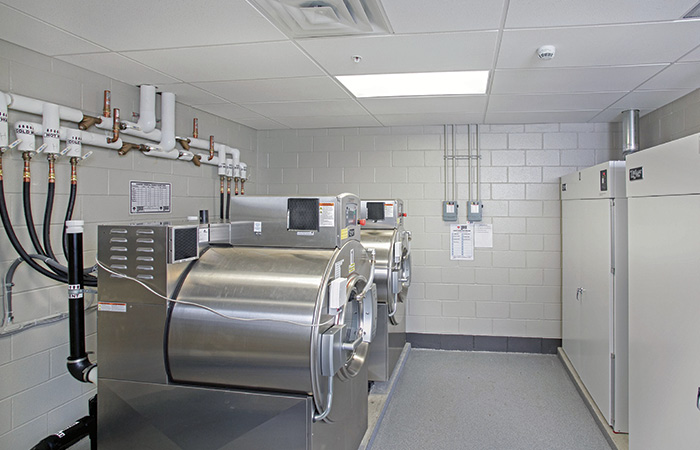



Solo Rescue and Interspiro were both displaying machines. The Interspiro machine is made by Electrolux, and the Solo Rescue machine carried its own brand name. The Solo Rescue machine was also capable of cleaning helmets, gloves, and footwear. The Interspiro booth personnel said they were also looking closely at the Solo Rescue machine for one they would use/recommend. Of the two machines, the Solo Rescue seemed to have more capabilities—i.e., being capable of washing other elements of the personal protective equipment (PPE) ensemble.
As we all know, almost all PPE cleaning has been focused on the fabric portion of PPE—turnout coats, turnout pants, and hoods. Most information about cleaning SCBA, helmets, gloves, and boots prescribes hand-cleaning. And, hand-cleaning is not a preferred method when machine cleaning is available. Most departments now have procedures for cleaning PPE, but many of them are applicable only to coats and trousers (in a washer/extractor). I doubt there are many fire departments or firefighters who hand wash their turnout coat and turnout pants. And, there are exposure risks when washing by hand.
A PPE cleaning study survey was taken at this year’s Fire Industry Education Resource Organization (F.I.E.R.O.) Fire PPE Symposium. Keep in mind that those in attendance are probably more in tune with PPE than most firefighters. One of the inquiries in the survey was, “Please rank which part of PPE is least likely to be cleaned.” The ranking was on a scale of 1 to 5 with 5 being the least likely. The least likely were boots (4.56), helmets (4.48), and SCBA (4.05). All of these ranked closely together. They were followed by gloves (3.38), the hood (2.32), and coats/trousers (2.23). Another question was, “Which PPE element is most difficult to clean?” Again, the scale was 1 to 5 with 5 being the most difficult. The most difficult was the SCBA (4.45), followed by helmets (4.23), gloves (4.14), boots (3.74), coats and trousers (2.62), and hoods (1.91). The survey validated the premise that there is need for a better way to clean SCBA, helmets, gloves, and footwear.
In years past, I have seen SCBA cleaning equipment in the European fire service and at Interschutz, which is held every five years in Germany. This was prior to the cancer awareness that we have now. I made note of the machines and wondered why they were not common in North America. Thus, seeing them at this year’s FDIC was especially noteworthy to me.
In addition to being a more user-friendly way to clean the nonfabric elements of PPE, the Solo Rescue machine provides a much speedier process. If the operator is efficient in loading and unloading the machine, it will clean up to 14 SCBA in an hour with an eight-minute cycle time. It cleans two at a time, including the air cylinder and the mask. With two basket inserts, the machine will also clean up to 60 helmets an hour, 120 pairs of gloves, and 40 pairs of boots with a two-minute cycle time.
With all the benefits of a machine like this, what are the downsides? The more than $20,000 price tag is a tough pill to swallow for most any organization. However, to get started, I don’t see a need for one of these in every fire station. I think the location model could be like SCBA refilling stations. They should be placed strategically among fire stations. For example, a municipal department could have one in every battalion, the training academy, and the logistics facility. Smaller departments could go to a countywide or regional basis. Perhaps a mobile unit is possible.
The stainless-steel unit occupies about the same space as a washer/extractor, being 40 inches wide and 35 inches deep. A minimum seven-foot ceiling is needed as the unit has two doors hinged horizontally. The top portion raises straight upward, while the lower portion flips down to form a working table type configuration for pulling out the baskets and loading the machine. The working surface is a comfortable 36 inches above the floor. Naturally, plumbing and electrical connections are required. It cleans by placing the contaminated elements in a basket that rotates while multiple moderate-pressure spray nozzles do the cleaning. The Solo Rescue Machine is made in Sweden, and the company has offices in Texas.
ROBERT TUTTEROW retired as safety coordinator for the Charlotte (NC) Fire Department and is a member of the Fire Apparatus & Emergency Equipment Editorial Advisory Board. His 34-year career includes 10 as a volunteer. He has been very active in the National Fire Protection Association through service on the Fire Service Section Executive Board and technical committees involved with safety, apparatus, and personal protective equipment. He is a founding member and president of the Fire Industry Education Resource Organization (F.I.E.R.O.).

